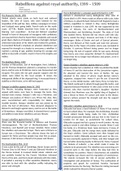ℝ𝕖𝕓𝕖𝕝𝕝𝕚𝕠𝕟𝕤 𝕒𝕘𝕒𝕚𝕟𝕤𝕥 𝕣𝕠𝕪𝕒𝕝 𝕒𝕦𝕥𝕙𝕠𝕣𝕚𝕥𝕪, 𝟙𝟛𝟡𝟡 – 𝟙𝟝𝟘𝟡
- Causes
- What happened
- Impact on king’s authority
Henry Bolingbroke’s campaign against Richard III, 1399
The Peasants’ Revolt, 1981 Richard II disinherited Henry Bolingbroke after John of
Violent attacks were made on both local and national Gaunt died in 1399. Henry made an alliance with Louis, duke
leaders, like John of Gaunt, who were blamed for the of Orléans, to attack Richard. Richard II left England to lead a
imposition of the poll tax. Also, military campaigns in France military expedition to Ireland in May. Henry Bolingbroke
and Scotland were going badly, French raids on the south landed in Yorkshire in July 1399. He was supported by the
coast, 1377-81. Rebels marched from Essex to London, duke of Orleans, the earls of Northumberland and
blaming ‘evil councillors’. 14-Year-old Richard acquitted Westmorland, and Archbishop Arundel. The duke of York
himself in front of thousands of insurgents with confidence also backed Henry. Richard did not return until late July.
and assured them that he heard their complaints and would Henry seized the king’s treasure and took 2 of the king’s
grant them charters of freedom. Within a fortnight, Richard messengers (duke of Exeter and earl of Surrey) prisoner.
witnessed executions of his rebels and revoked his pardons. Henry met Richard at Flint Castle and took him prisoner,
It presented Richard’s emphasis on absolute obedience and taking him to the Tower of London. Henry was coronated in
exposed his strength as a leader to overcome a rebellion. It October. It portrays Richard losing power and no longer
marked a coming of age, publicly showing his courage and being king. His lack of support while he was away showing
ability to deal with a hostile crowd in front of his knights and how Henry was more powerful. Richard II’s imprisonment
nobles. meant that he no longer had influence and power, as he is
no longer king.
The Epiphany Rising, 1400
Number of Richardians, Earl of Huntingdon, Kent, Salisbury, Owain Glyndwr’s rebellion against Henry IV, 1400
and Sir Thomas Despenser planned a conspiracy to murder Owain Glyndwr led a rebellion in 1400. He plotted the death
Henry and his sons at Christmas. Henry was forewarned and of Henry IV and the destruction of the Lancastrian regime.
escaped. The plans did not gain popular support and the He attacked and burned the town of Ruthin. He was
rebels were killed by the local people. It shows the elevated to the status of prince. Hugh Burnel, Henry’s
widespread dislike of the deposed king. It increased Henry’s supporter, stopped him. Henry IV put his son 13-year-old
stability on the throne, as he still had support. Henry, on the Welsh border, with Henry Percy to help him.
The Welsh continued to attack through guerrilla tactics, and
Hotspur’s rebellion against Henry IV, 1403 captured Edmund Mortimer IV (the uncle of the heir to the
The Percies, including Hotspur, were frustrated as they throne), who then married Glyndwr’s daughter. Glyndwr
argued with Henry over how to manage the Scots, they claimed that Mortimer was the rightful king of England. It
wanted more money, Hotspur’s wife was a Mortimer, and was a threat to Henry IV’s power and claim to the throne.
Hotspur was jealous of Henry’s son, Prince Hal. Also, they Henry’s actions present his strength and also his support
were overstretched with responsibility for Welsh and against the rebels.
Scottish borders. Hotspur rebelled and was joined by his
uncle, the Earl of Worcester. They declared allegiance to Oldcastle’s rebellion against Henry V, 1414
Richard II and fought against Henry and his son at the battle Oldcastle had been a loyal follower of Henry IV but started
of Shrewsbury. Hotspur was killed. It showed Henry’s power to have Lollard ideas. For example, the Archbishop, Arundel,
and ability to take down rebellions and any threats. found Lollard books being made for him. Archbishop
Arundel prosecuted Oldcastle and put him in the Tower of
Scrope’s rebellion against Henry IV, 1405 London for 40 days, as punishment for Lollard ideas.
There was the financial burden of defence and financial Oldcastle escaped and led a group to north London. He was
mismanagement. The Earl of Northumberland, Thomas going to sneak in and either kidnap or murder Henry V and
Mowbray, Lord Bardolf and Scrope rebelled. Henry ended his family at a Christmas feast. Spies led Henry V know of
the rebellion and executed Scrope. There were criticisms as the plot. Oldcastle and his troops were easily defeated by
Scrope was a Churchman. The criticism shows the lack of the king’s soldiers. Some Lollards were then hanged and
support for Henry and how people may view him as unjust. burned (or both). Oldcastle escaped and went on the run.
However, it did remove a threat to his power and throne. He was eventually captured in Wales, and then hanged and
burned (after declaring loyalty to Richard II). Henry V passed
The Southampton Plot, 1415 the ‘Statute of Lollards’, a law which made it easier for
It was a plot by the earl of Cambridge, Baron Scrope and Sir Lollards to be prosecuted. The rebellion was concerning as it
Thomas Grey to kill Henry V and put Edmund Mortimer in occurred early in the reign before the king had time to
the throne instead. It involved Welsh rebels, Lollards and consolidate his position. Henry’s decisiveness ad suitability
was partially funded by the French. Mortimer informed for kingship was shown and his reputation of omniscience.
Henry of the plot, and Henry dealt ruthlessly with the rebels. The statute increased the role of secular authorities in
It provided a warning to other would-be dissidents. Henry investigation and protection of heresy. The confiscation of
was able to deal with the rebellion swiftly indicating his property and goods for convicted heretics increased
power and strength. potential income for the king. The fines for rioting increased
which reduced the threat to Henry’s power.




